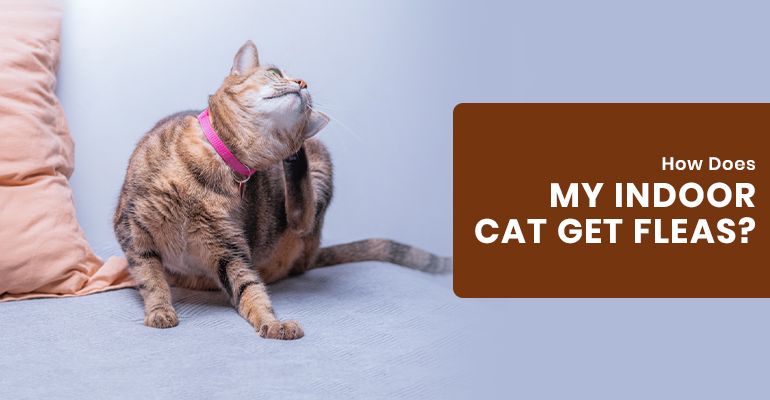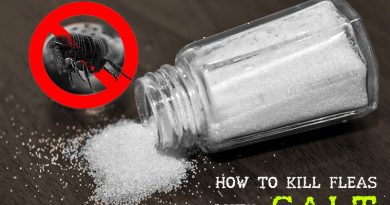How Does My Indoor Cat Get Fleas?
It does not come as a surprise that even indoor cats are prone to getting infected with fleas. There is a comparatively low risk of indoor cats attracting fleas, but still, they are no exception to it. Multiple reasons can cause your indoor cat to get fleas.
In this blog, we’ll understand in detail how fleas develop, why cats get fleas, and how to use preventative treatments to get fleas out of your cat’s fur. Let’s begin with learning about the flea’s lifecycle.
Life Cycle of Fleas
When we think of fleas, we think of the adult flea, but fleas have numerous forms when they’re developing. Knowing the different phases of flea development can help us respond promptly to an invasion. Mainly, fleas have four life stages of their growth. Let’s know them in sequence:
1) Flea Eggs – For an adult female flea to lay eggs, it has to feed on a blood meal of its host, because blood is necessary for production. Female fleas usually lay about 40 eggs per day on their host’s skin or in the pet’s fur. Flea eggs can be identified as tiny white things, similar to the size of a sand grain, present in your cat’s fur and are found in bunches of about 20 eggs. Eggs do not stick to the skin and roll down into the host’s environment.
2) Larvae – These eggs break in approximately twelve days and the larvae hatch out of the flea egg. These larvae move deep into a dark and warm spot to build a cocoon to grow in it. The best example is the carpet fibres or under the bedding.
3) Pupae – In the cocoon these larvae grow into pupae. Till they find a host nearby, they stay safely in the cocoon. The process of pupae to adult flea may take up to months and this pupa may remain unaffected by winter weather, pesticides, or any adverse conditions. In a favorable and humid environment, the adult flea emerges out of the cocoon within 5 days to a week. And when conditions are not favorable, the pupa can take up to a year to develop into an adult flea.
4) Adult Flea – When a pupa emerges from its cocoon, it turns into an adult flea and it must begin feeding on a host within a few hours. Adult fleas will breed shortly after the initial feeding and begin laying eggs within a few days. Or just after hopping onto a host the adult flea feeds and begins to lay more eggs on its host’s body.
Why Are Fleas So Dangerous?
Fleas are the most common external parasites that cats get infected with. These pesky parasites are a cause of several diseases and are harmful to your cat’s health. If fleas are present in large quantities in your cat’s fur, it can cause Anemia in your little kitty. Below is a list of health risks and diseases caused by fleas:
- Flea allergy dermatitis – This very common allergic skin reaction is caused by flea bites in pets.
- Flea Tapeworms – Flea Tapeworms are intestinal parasites that infest cats and even humans on accidental ingestion of an infected flea.
- Cat scratch disease – This skin infection is caused by Bartonella a bacterium that penetrates the wounds from flea feces or flea dirt.
- Hemoparasites – Mycoplasma Haemofelis is a blood parasite that can infect your cat and remain in your cat’s blood for years without any symptoms. Its noticeable effects are fever, lethargy, loss of appetite and anemia when triggered by other diseases like FeLV or stressful events.
Know in Detail About : Cat Scratch Fever In Cats
5 Ways Indoor Cats Get Fleas
It is essential to know what to observe to avoid flea infestation and keep your cat safe and flea-free. Fleas at any stage of their lifecycle can be troublesome for your cat and its environment. Here are 5 ways cats can get fleas:
1. From Other Pets
A flea may hop onto other outdoor pets, like your dog, and bring the fleas into your household. This is the most common way indoor cats get fleas. Your cat is not safe from flea infestation even though your dog is on flea-preventative treatment. Some fleas may jump from your dog onto your cat before being killed by the flea treatment, causing your cat discomfort.
2. From Other Humans
Be careful while welcoming guests at home. As a precautionary measure, you can request your guests to leave their shoes outside the main door. You may never know if a flea egg or a flea larva maybe hiding in their shoe or is tucked on their shoes. This can help keep the harmful parasite out of your home. What if your guest was coming from an environment infected with fleas? It is always better to disinfect your guest’s clothing and belongings before allowing them in your house.
3. From Rodents in The Household
If your household has rodents like mice or rats going to and fro from your home, they can act as a carrier of fleas to your home and eventually to your cat. No matter what the flea species – dog fleas, cat fleas, and rat fleas – all are the same and they keep moving from one host to another to feed themselves.
To avoid the spread of fleas from rodents, take precautions for keeping your premises rodent-proof.
4. By Sharing Supplies and Household Items
Give a good inspection to items, next time you buy from a thrift shop or before swapping pet supplies. These blood-sucking parasites may be hiding in the brush bristles you want to buy for your pet or maybe in any clothing that you intend to buy. Good quality secondhand products are good to use but thoroughly sanitizing and removing flea dirt before using is a good practice.
5. From Traveling To Places
Your cat may be staying indoors the whole year round, but you may have to take it out to see the vet, visit the groomer, travel with you or reside at a boarding facility. The time your cat steps out of your home, it is at great risk of picking up fleas from the environment it goes to or from other pets that are already infected by fleas.
Prevention of Fleas and Ticks for Indoor Cats
Even though your cat remains indoors it is a good idea to keep all the household pets on flea preventative treatments. It is the best defense practice to avoid your cat from getting infested with fleas. Listed below are a few of the most effective and vet-approved flea preventatives for cats which are available on our website at discounted prices:
These preventions come in various age, and weight limits. Please make sure you order according to your pet’s size, weight and age to avoid overdosing your feline friend.
Wrapping Up
Fleas are a big threat even to indoor cats. Many cats have allergic reactions from flea bites which may cause itching and skin irritation. Kittens are at high risk, if they are infested with fleas, as it can cause them anemia.
Fleas are the main mode of parasite transmission, and tapeworms and Bartonellosis may easily enter your cat’s intestine through them. Watching out for fleas and taking preventative measures to curb them are remarkable habits to ensure the good health and safety of your cat and your family.




